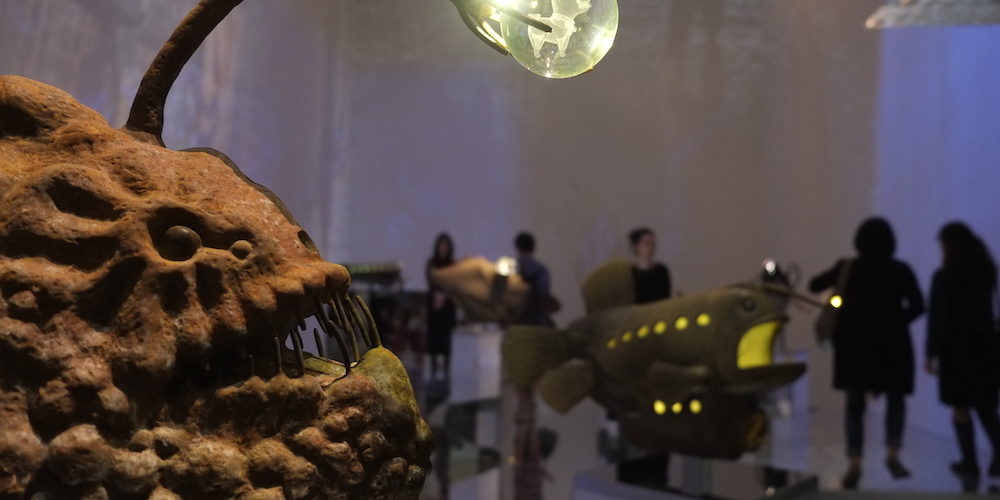Love at first…bite? The bizarre love life of the deep-sea anglerfish

The ocean is vast and there are certainly plenty of fish in the sea but finding that special someone can’t be easy. Especially for those inhabiting its deepest darkest depths. To us, the deep-sea is a mysterious and alien world, teeming with strange and wonderful creatures. To them, it is home. Descending down into the abyssal depth of our oceans, beyond 200m, sunlight turns to murky shadows and darkness envelopes the world. The environmental pressure increases and temperatures drop uncomfortably below 5 oC. Food is limited. No sunlight means no photosynthesis – plants can’t convert sunlight into energy. This turns sinking surface debris, such as plankton remains (also known as “marine snow”), dead animal carcasses and marine plants into ocean delicacies1. That, or prowling for other creatures dwelling in the deep…
Let’s face it, the deep-sea doesn’t sound like an easy place to live in, let alone find Prince Charming. For decades, one peculiar group of deep-sea residents, the deep-sea anglerfish, have stumped scientists with their unique take on this age-old dilemma; for some species, the males and females fuse together forever becoming a single entity floating through the darkness. Their puzzling love lives read like a work of science fiction (or even a horror movie). How are these fish able to stay attached together without their bodies’ defence systems killing one or the other? The answer baffled scientists for decades. Until now.
The bizarre-looking anglerfish
Anglerfish definitely leave a lasting impression. With the enormous heads, proportionally tiny bodies, massive mouths and sharp teeth grimacing back at you, they look like a living nightmare. But what do we know about these angry looking fish? Not a lot. Living at such depth, studies into anglerfish behaviour in the wild are rare and the recovery of specimens intact for research poses even more challenges.
Anglerfish are bony fish with approximately 200 species that live in the deep-sea2. They lurk within the inkey darkness, some 300 metres below the ocean surface. Deep-sea anglerfish are dark brown or dark grey carnivorous fish, ranging from around 2 centimetres to over 100 centimetres in length3! Anglerfish show extreme sexual dimorphism4. This means females and males are very different sizes. Size differences between the sexes of a species are not unusual, with the larger sex often male. However, for anglerfish the opposite applies; males are tiny, really tiny. For example, the male Kroyer’s deep-sea anglerfish5 measure roughly 16 centimetres in length, whereas females can reach over 1 metre! However, for most anglerfish, the size difference is less extreme; many female anglerfish are about the size of a large teacup. But that’s not all that differs between the sexes; adult female and male anglerfish look very different.
Mature females have the familiar anglerfish appearance. Their massive heads contain cavernous jaws filled with a multitude of needle-like, transparent teeth. On the top of their nose, swinging off the end of a dorsal fin spine (the Illicium), a fleshy blob hangs, a bit like an upside-down lightbulb (the esca). Within the esca, bioluminescent bacteria live, lighting up the surrounding darkness6. Female anglerfish wiggle this light around in front of their face, tempting in unsuspecting prey. With a target in sight, the female summons a sudden burst of energy, clamping down her abyssal mouth, trapping her meal within a prison of teeth. At these depths, female anglerfish can’t be picky; shrimp, squid, turtles, fish and even sunken birds are on the menu. And if that wasn’t enough, the stomach and jaws of this impressive predator can expand to allow meals two times the size of the fish itself7.
Males, however, are pretty petite. With tiny, serrated knife-like teeth (denticles) and keen senses (some have good eyesight and some have a great sense of smell)8. It’s hard to imagine these males are even the same species as their massive female counterparts. Ordinarily, heightened senses make prey finding easy, but they aren’t after their next meal – the males just want to mate.

Till death do us part
Just like any normal relationship, anglerfish males seek out sex, food, security and companionship but it comes at a cost. Deep-sea anglerfish engage in sexual parasitism9. So what happens when a male finds a female? He gives her the kiss of a lifetime… literally! When the two meet, the male anglerfish bites on to the belly of the female like a parasite. Some females can even host multiple males. Sometimes these attachments are temporary but some become permanent; if the latter happens, and here’s the really disturbing part, the male releases an enzyme to digest away his face. At the same time, he digests a hole in the female causing the two to fuse together eternally right down to their blood. Eventually, he becomes nothing more than a little purse full of sperm to fertilise her eggs. In exchange, she feeds him and keeps him safe. Not the most conventional relationship, even throughout the animal kingdom. What makes this type of relationship so bizarre is that their relationship becomes similar to that of conjoined twins, yet they were not born joined together. So why doesn’t the female’s immune system (the body’s defence systems against foreign material) reject her newly acquired mate(s)?
Please don’t reject me
The immune system of vertebrate animals (animals with a backbone) can tell the difference between ‘self’ (your own) and ‘non-self’ (foreign) tissue. On the surfaces of most of our cells, specialised proteins, known as major histocompatibility complex (MHC) class 1 proteins sit. MHC proteins are very different from person to person, meaning it’s very unlikely someone will have the exact same MHC molecules as you; this is how our bodies tell the difference. MHC molecules hold small protein pieces (peptides) that come from inside of the cell onto the surface. When a T-cell (a type of immune cell) passes by, it can check what peptides are there; if they are yours, it moves on. If not, T-cells can attack and destroy the cell10. But this doesn’t happen in deep-sea anglerfish. The female doesn’t reject the male. In fact, it seems she has no real say at all in the relationship.
Almost a century since the puzzling remains of a female anglerfish and her two tiny attached mates landed in the British Museum of Natural History11, we now might have an answer why. By examining the DNA sequences (the genetic blueprint of each organism) of 10 different anglerfish species, scientists uncovered a shocking discovery about the anglerfish immune system. It doesn’t seem to function like ours. By comparing species with permanently attaching males to those which show temporary attachments or no attachments at all during mating, researchers found permanently attaching couples lacked a lot of MHC class 1 diversity. This means they probably aren’t very good at presenting ‘self’ and ‘non-self’ peptides to T-cells. Researchers also found the anglerfish T-cell response is likely weakened and other parts of the immune response seem impaired including the ability of some species to produce antibodies. Antibodies are proteins capable of binding to foreign material in the body, marking it for destruction. What’s more, these differences weren’t sex specific; if it was lost in the male, it was lost in the female too12.
What can learn from anglerfish immunity?
The immune system of vertebrates is a vastly complex defence mechanism, and until now, how it worked was thought to be the same between species. Somewhere along the line, it seems deep-sea anglerfish ignored this, taking their own approach. Now, researchers are working to explore the evolution of these drastic immune system alterations by looking at species which might be undergoing changes towards a sexual parasitic-type relationship.
It’s unlikely any other organism could survive with the immune system of a deep-sea anglerfish, yet these fish remain successful predators of the deep. In a human, a deficient immune system like this would cause diseases, for example, arthritis, where your immune response attacks your own tissue.
However, an immune system like this would also allow successful organ transplants from one human to another. In fact, recipients of donor organs must take immunosuppressive drugs for the rest of their lives to prevent damage to the ‘non-self’ organ. By studying anglerfish immunity, could we learn more about alternative ways of ‘self’ and ‘non-self’ recognition by the immune system to improve how we transplant organs and autoimmune conditions? And what about other infections these fish may get? How do they protect themselves? We could be looking at a new kind of immune system. We still don’t know but this unique approach to love is challenging conventional views on how the importance of our immune system and just how adaptable it really is.
This article was specialist edited by Sebastian Kirchner and copy edited by Katrina Wesencraft.
References
- https://marinebio.org/oceans/deep-sea/
- https://science.sciencemag.org/content/sci/early/2020/07/29/science.aaz9445.full.pdf
- https://oceanexplorer.noaa.gov/forfun/creatures/facts/kids_guide_anglerfish.pdf
- https://www.nhm.ac.uk/discover/bizarre-love-life-of-the-anglerfish.html
- https://www.fishbase.se/summary/4572
- https://oceana.org/marine-life/ocean-fishes/deep-sea-anglerfish
- www.nhm.ac.uk/discover/mystery-of-hairy-anglerfish-huge-stomach.html
- https://www.nhm.ac.uk/discover/bizarre-love-life-of-the-anglerfish.html
- https://www.nationalgeographic.com/news/2018/03/anglerfish-mating-rare-video-spd/
- www.immunology.org/public-information/bitesized-immunology/systems-and-processes/antigen-processing-and-presentation
- www.tailsthroughtime.com/the-unusual-mating-habit-of-the-anglerfish/
- https://science.sciencemag.org/content/sci/early/2020/07/29/science.aaz9445.full.pdf










